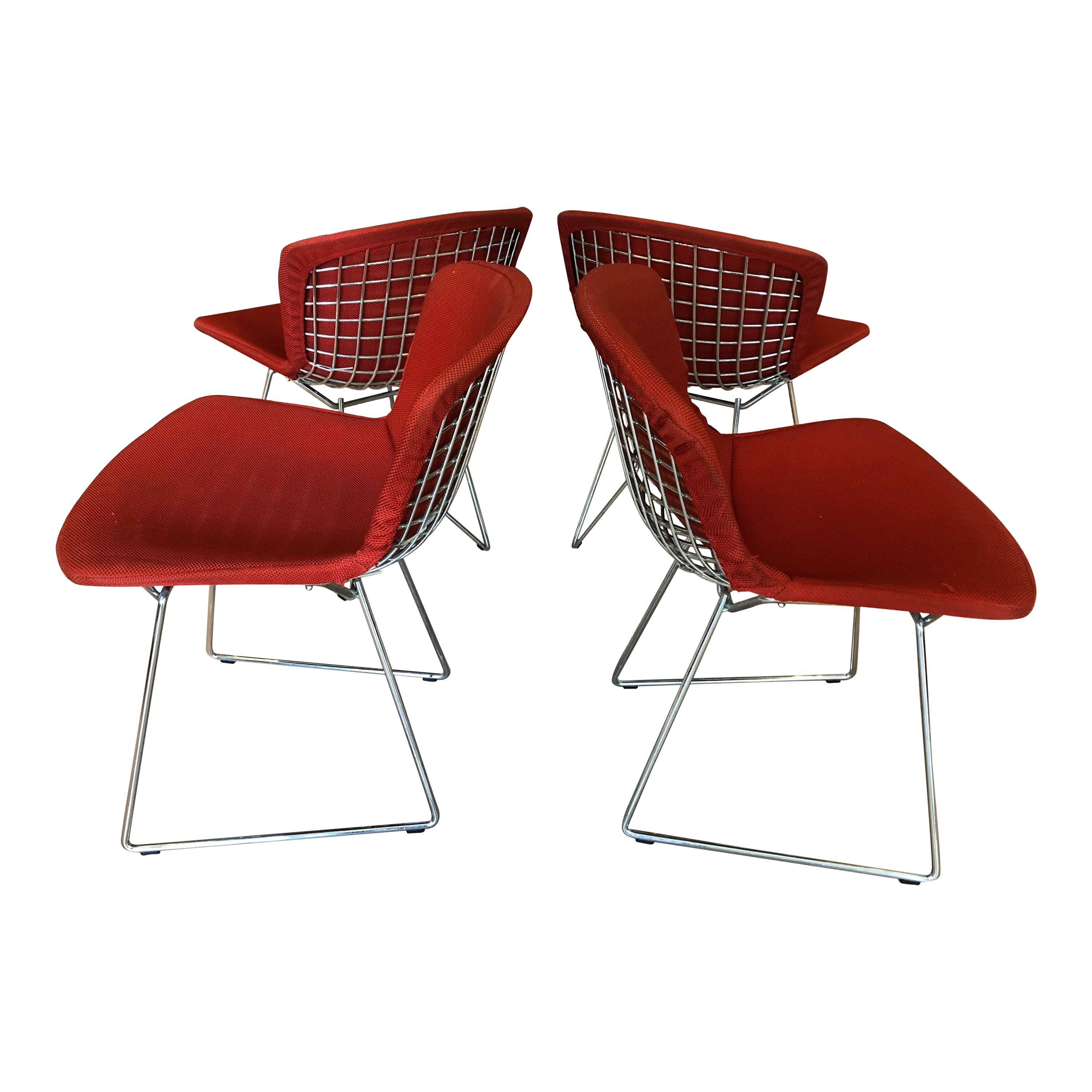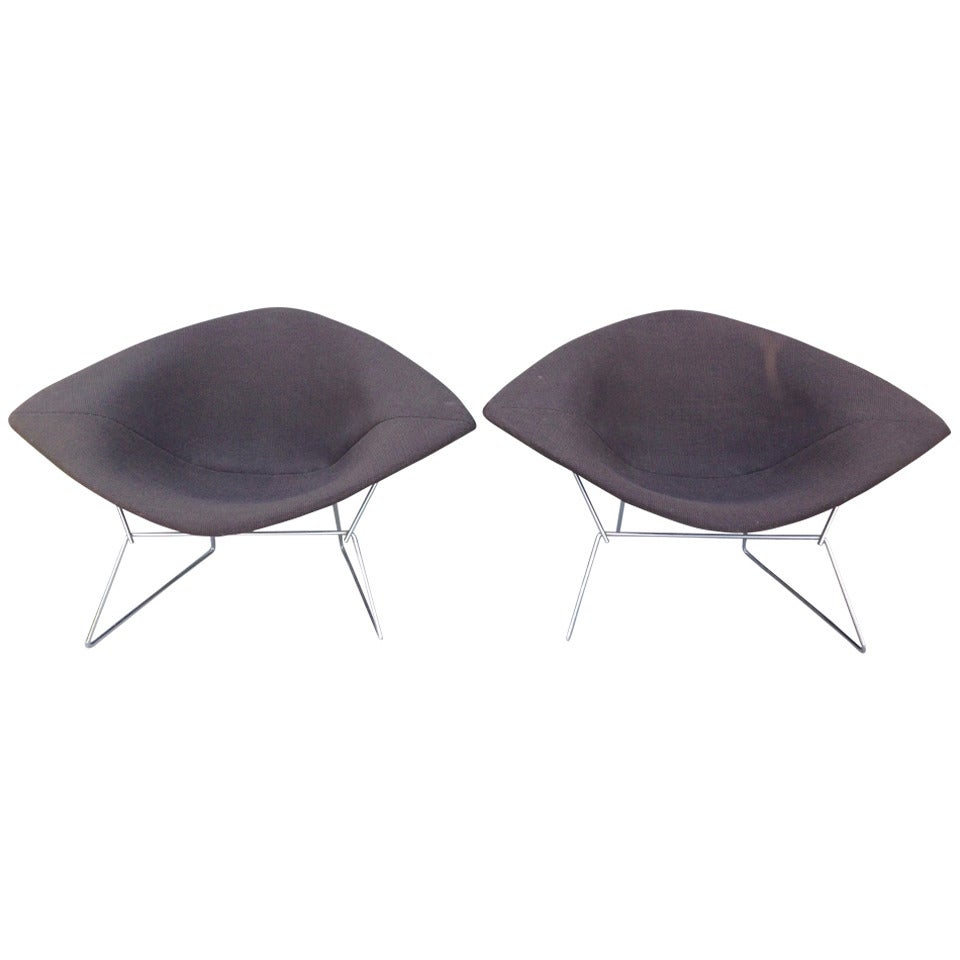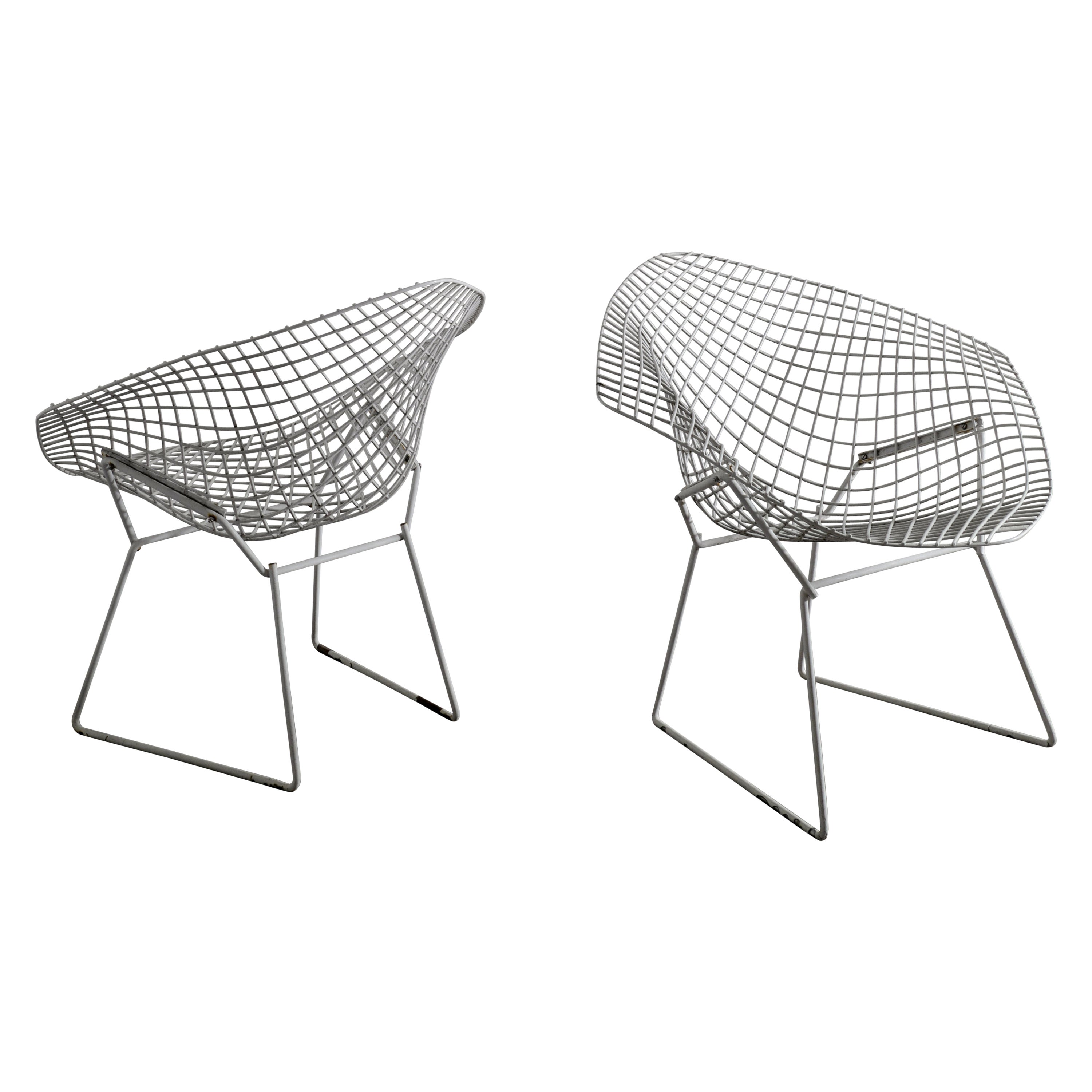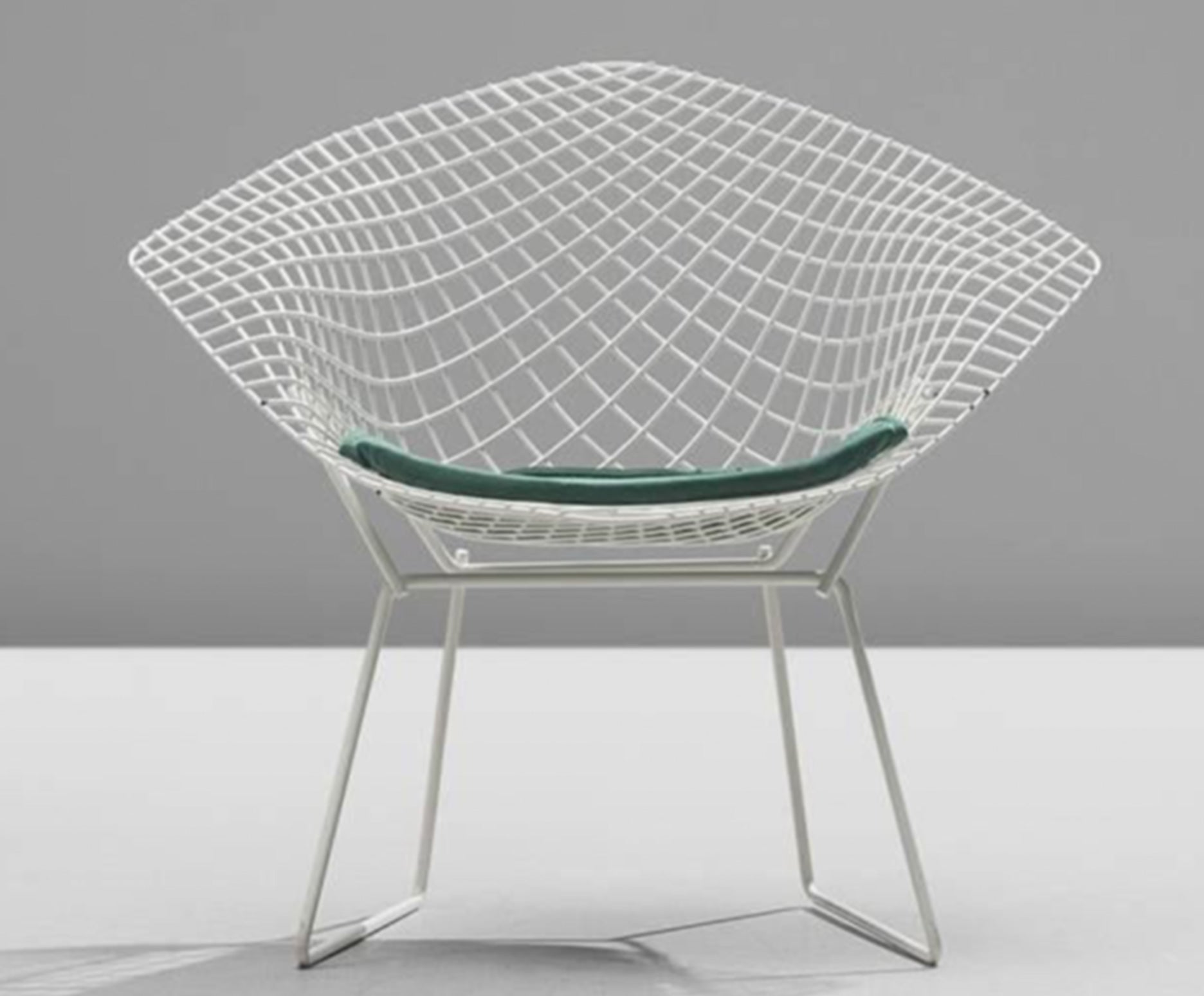Bertoia Diamond Chairs, White, Set of Two, Welded & Painted Steel
About the Item
- Creator:Harry Bertoia (Designer)
- Design:
- Dimensions:Height: 29.5 in (74.93 cm)Width: 33.5 in (85.09 cm)Depth: 29.5 in (74.93 cm)Seat Height: 17.75 in (45.09 cm)
- Sold As:Set of 2
- Style:Mid-Century Modern (Of the Period)
- Materials and Techniques:Steel,Welded
- Place of Origin:
- Period:
- Date of Manufacture:1950s
- Condition:Wear consistent with age and use. Harry Bertoia's 1950 experiment with bending metal rods into practical art produced a revered collection of seating, including the exquisite Bertoia side chair. Innovative, comfortable, strikingly handsome, strong & durable.
- Seller Location:Bloomfield Hills, MI
- Reference Number:1stDibs: LU7781233485642
Diamond Chair
To fully understand the design of Harry Bertoia’s (1915–78) 1952 Diamond chair — an austere and photogenic work of woven steel wire, the intricately sculptural wings of which create the illusion of sitting on air — it helps to go back to his college days: In 1937, the Italian-born artist and designer, who emigrated to Detroit at age 15, earned a scholarship to Cranbrook Academy of Art, the illustrious Michigan design school that attracted such luminaries as Florence Knoll, Eero Saarinen and Charles and Ray Eames. Bertoia was deeply influenced by the Eameses, especially by the sculptural quality that was so prominent in the furniture they made. In the 1940s, he left Cranbrook to work for the couple, developing the molded plywood furniture that would become a trademark of their designs.
Bertoia learned to weld while employed by the Eameses, but left their workshop in anger over the lack of credit he received for the important contributions he made there — a dispute that would come to play an important role in the Diamond chair’s development. He eventually took a job at an electronics lab, where he analyzed human mobility for the purpose of designing electronics with easy-to-reach knobs and consoles.
When his former Cranbrook classmate Florence Knoll tapped Bertoia to make furniture for the Pennsylvania company she had recently founded with her husband, Hans, the designer was swayed with the promise of full credit for designs he produced. Armed with a newly minted background in ergonomics as well as the knowledge he gathered from experimentation with the Eameses, Bertoia capably applied what he’d learned over the years at Knoll, where he utilized thin wires of welded metal to produce pieces that appeared to be floating in the wind — yet remained surprisingly comfortable and supportive. The Diamond chair, a widely revered component of the innovative metal furniture line that Bertoia designed at the company, has been in continuous production at Knoll since 1952 and is available in four finishes today.
Harry Bertoia
Sculptor, furniture and jewelry designer, graphic artist and metalsmith, Harry Bertoia was one of the great cross-disciplinarians of 20th-century art and design and a central figure in American modernism. Among furniture aficionados he is known for the wire-lattice Diamond chair (and its variants such as the tall-backed Bird chair) designed for Knoll Inc. and first released in 1952. As an artist, Bertoia is revered for a style that was his alone. Bertoia’s metal sculptures are by turns expressive and austere, powerful and subtle, intimate in scale and monumental. All embody a tension between the intricacy and precision of Bertoia’s forms and the raw strength of his materials: steel, brass, bronze and copper.
Fortune seemed to guide Bertoia’s artistic development. Born in northeastern Italy, Bertoia immigrated to the United States at age 15, joining an older brother in Detroit. He studied drawing and metalworking in the gifted student program at Cass Technical High School. Recognition led to awards that culminated, in 1937, in a teaching scholarship to attend the Cranbrook Academy of Art in suburban Bloomfield Hills, one of the great crucibles of modernism in America. There, Bertoia made friendships — with architect Eero Saarinen, designers Charles and Ray Eames and Florence Schust Knoll and others — that shaped the course of his life. He taught metalworking at Cranbrook, and when materials rationing during World War II limited the availability of metals, Bertoia focused on jewelry design. He also experimented with monotype printmaking, and 19 of his earliest efforts were bought by the Guggenheim Museum.
In 1943, he left Cranbrook to work in California with the Eameses, helping them develop their now-famed plywood furniture. (Bertoia received scant credit.) Late in that decade, Florence and Hans Knoll persuaded him to move east and join Knoll Inc. His chairs became, and remain, perennial bestsellers. Royalties allowed Bertoia to devote himself full-time to metal sculpture, a medium he began to explore in earnest in 1947.
By the early 1950s Bertoia was receiving commissions for large-scale works from architects — the first came via Saarinen — as he refined his aesthetic vocabulary into two distinct skeins. One comprises his “sounding sculptures” — gongs and “Sonambient” groupings of rods that strike together and chime when touched by hand or by the wind. The other genre encompasses Bertoia’s naturalistic works: abstract sculptures that suggest bushes, flower petals, leaves, dandelions or sprays of grass. As you will see on these pages, Harry Bertoia was truly unique; his art and designs manifest a wholly singular combination of delicacy and strength.
- ShippingRetrieving quote...Ships From: Detroit, MI
- Return PolicyA return for this item may be initiated within 14 days of delivery.
- Bertoia, Eight White Welded Steel Chairs with Four Red CushionsBy Harry BertoiaLocated in Bloomfield Hills, MISALE ONE WEEK ONLY This set of eight side chairs & four red cushions are as elegant, strong and functional as when they were manufactured. The colors are bright and the cushions are in very good condition. The chairs will add a touch of class to any setting. Harry Bertoia's career began in the 1930s as a student at Cranbrook Academy of Art where he re-established the metal-working studio and later became head of the department before the school closed during WWII due to wartime restrictions on materials in 1943. During the war, Bertoia moved to California and is credited with developing new techniques for molding plywood with Charles and Ray Eames also from Cranbrook. Harry Bertoia is one of the many well-known artists and designers who attended The Cranbrook Academy of Art in Bloomfield Hills, Michigan, The school & buildings were designed by architect and faculty member, Eliel Saarinen who collaborated with Charles and Ray Eames on chair and furniture design. It is the country’s top ranked, graduate-only program in architecture, design and fine art. Each year, just 75 students are invited to study and live on the landmark Saarinen-designed campus which features: private studios, state-of-the art workshops, the renowned Cranbrook Art Museum and 300 acres of forests, lakes and streams, all a short drive from the city of Detroit. The focus at Cranbrook is on studio practice in one of ten disciplines including Architecture, 2D and 3D Design, Ceramics, Fiber, Metalsmithing, Painting, Photography, Print Media, and Sculpture. The program is anchored by celebrated Artists- and Designers-in-Residence, one for each discipline, all of whom live and practice on campus alongside the graduate students. Numerous creative artists who are alumni of Cranbrook include: Florence Knoll, Jack Lenor Larsen, Donald Lipski, Duane Hanson, Nick Cave, Hani Rashid, George Nelson, Urban Jupena (Nationally recognized fiber artist), Artis Lane (the first African-American artist to have her sculpture, "Sojourner Truth," commissioned for the Emancipation Hall in the Capital Visitor Center in Washington DC), Cory Puhlman (televised Pastry Chef extraordinaire), Thom O’Connor (Lithographs), Paul Evans (Brutalist-inspired sculpted metal furnishings), Eugene Caples (small bronze images/abstract), Morris Brose (Bronze Sculptures), Herb Babcock (blown glass), Larry Butcher (mixed media), Lauren Anais Hussey (Abstract), Andrea Eis (film, photography), Lilian Swann Saarinen (Sculpture), Douglas Semivan...Category
Mid-20th Century American Mid-Century Modern Chairs
MaterialsMetal, Steel
- Monumental Harry Bertoia Silver Necklace, Bertoia Catalogue Raisonne D.JE.49By Harry BertoiaLocated in Bloomfield Hills, MIWEARABLE ART AN IMPORTANT DESIGN FOR A NECKLACE The necklace is unique and extraordinary. Because of its specific design elements it lays beautifully and comfortably on any body structure. This piece comes from a private collection. Provenance will accompany the piece. It has been authenticated by Val Bertoia and is listed in the Harry Bertoia Foundation Catalogue Raisonne # D.JE.49 having been authenticated as a Harry Bertoia piece. REPLY FROM CHRISTIE'S: "Dear Charles, thank you for contacting Christie's. I am absolutely stunned to see the necklace by Harry Bertoia you have submitted for feedback from us, and I would love to speak with you about the work at your earliest convenience. I am a great fan and a known expert in the work of Harry Bertoia, and I have handled over 600 of his sculptures, jewelry and art over the last 22 years. I have never seen a better piece of his jewelry, and it stands as one of the greatest objects in any category that he made. Michael Jefferson Senior Vice President International Senior Specialist Design" The following is from Beverly H. Twitchell, PhD, author of Bertoia: The Metalworker, London: Phaidon, 2019. She provides a very informative critique of Bertoia and his jewelry. Wearable Art an Important Design for a Necklace “Before Harry Bertoia enrolled at the Cranbrook Academy of Art in 1937 he had already mastered traditional jewelers’ techniques, but his engagement with Modernism led him to invent and use more direct methods. Instead of precious metals and gems, Bertoia made jewelry that appealed through its design, craftsmanship and the nature of its materials. That approach would make Bertoia a direct predecessor of the American Studio Crafts movement. So complex and cumulative are human perception and memory that we often do not know from where our own ideas come and without firm evidence, it is impossible to think we can establish the origins of an artist’s ideas. While his jewelry is entirely modern, chokers with multiple small pendants had come from ancient Mediterranean cultures: Mesopotamia, Egypt, Greece and Italy, even from Europe and America at the turn of the last century. Did Bertoia see works in books, journals or at the Detroit Institute of Arts that resonated with him or did he invent this on his own, as he would so many other forms? Bertoia found inspiration in nature from an early age on a small farm in Italy and later in Cranbrook’s woods, on the beaches of southern California and in the fields near his home in eastern Pennsylvania where he lived after 1950. The fluidity and motion of the his jewelry characterize much of his art. In that spirit, too, he made jewelry that suited human anatomy and was animated by its wearer’s movement. Bertoia had the instincts of an engineer, as the intricacy of the present lot’s clasp and overall construction of the jewelry demonstrates. Large jewelry by Bertoia is very rare. A delight to the eye, and like all of Bertoia’s work it is timeless. Bertoia had the instincts of an engineer, as the intricacy of the present lot's clasp and the overall construction of this piece demonstrate. Closed, the necklace sits on a table in a surprisingly conical shape, but it is so flexible that it conforms to its wearer from her neck nearly to her shoulders. Each handmade section is riveted to its neighbors, allowing it to adjust to the body while the pendants curve in many directions: one fits the left clavicle so precisely that Bertoia likely tried it on Brigitta Valentiner, who became his wife in 1943. Other pendants face toward or away from each other, bending up or down. Each element has been hammered into multiple curves and worked in Bertoia’s hands. Large jewelry by Bertoia is very rare. A delight to the eye, this necklace no doubt caused a sensation in its day as it might at the 2022 Met Ball in ours, for like all of Harry Bertoia’s work, it is timeless.” Harry Bertoia (1915 – 1978) was an Italian-born American artist, jewelry creator and modern furniture designer. He was born in San Lorenzo d...Category
Vintage 1940s American Abstract Sculptures
MaterialsSterling Silver
- Rare Harry Bertoia Sterling Silver Brooch "Ginko Leaves" ca. 1940sBy Harry BertoiaLocated in Bloomfield Hills, MIAn extremely rare Harry Bertoia sterling silver brooch "Ginko Leaves." The brooch has been added to the Harry Bertoia Catalogue Raisonné and assigned the following catalogue raisonné number: D.JE.77. This piece comes from a private collection. Provenance will accompany the piece. The Brooch measures: 2.94 " long x 1.5 " wide x .30 " deep. Although associated with Mid-Century Modern furniture, Harry Bertoia was originally a jewelry designer who used both sterling silver, precious stones and gem stones. The brooch and closure are all handcrafted and the clasp is his unique design. The following is from Beverly H. Twitchell, PhD, author of Bertoia: The Metalworker, London: Phaidon, 2019. She provides a very informative critique of Bertoia and his jewelry. Wearable Art an Important Design for a Necklace “Before Harry Bertoia enrolled at the Cranbrook Academy of Art in 1937 he had already mastered traditional jewelers’ techniques, but his engagement with Modernism led him to invent and use more direct methods. Instead of precious metals and gems, Bertoia made jewelry that appealed through its design, craftsmanship and the nature of its materials. That approach would make Bertoia a direct predecessor of the American Studio Crafts movement. So complex and cumulative are human perception and memory that we often do not know from where our own ideas come and without firm evidence, it is impossible to think we can establish the origins of an artist’s ideas. While his jewelry is entirely modern, chokers with multiple small pendants had come from ancient Mediterranean cultures: Mesopotamia, Egypt, Greece and Italy, even from Europe and America at the turn of the last century. Did Bertoia see works in books, journals or at the Detroit Institute of Arts that resonated with him or did he invent this on his own, as he would so many other forms? Bertoia found inspiration in nature from an early age on a small farm in Italy and later in Cranbrook’s woods, on the beaches of southern California and in the fields near his home in eastern Pennsylvania where he lived after 1950. The fluidity and motion of the his jewelry characterize much of his art. In that spirit, too, he made jewelry that suited human anatomy and was animated by its wearer’s movement. Bertoia had the instincts of an engineer, as the intricacy of the present lot’s clasp and overall construction of the jewelry demonstrates. Large jewelry by Bertoia is very rare. A delight to the eye, and like all of Bertoia’s work it is timeless.” Harry Bertoia (1915 – 1978) was an Italian-born American artist, jewelry creator and modern furniture designer. He was born in San Lorenzo d-Arzene, Pordenone, Italy. At age 15 he moved to Detroit, Michigan to live with his older brother, Oreste. He quickly learned English and the bus schedule and enrolled in Cass Tech High School in Detroit (1930-1936) where he studied art and design and learned the skill of handmade jewelry making. At that time, there were three jewelry and metals teachers Louise...Category
Mid-20th Century American Mid-Century Modern Abstract Sculptures
MaterialsSterling Silver
- Extremely RareHarry Bertoia Necklace Sterling Silver Lapis Coral ca. 1940By Harry BertoiaLocated in Bloomfield Hills, MIExtremely rare combination pendant attached to custom-made chain by Harry Bertoia in sterling silver, containing one Lapis Lazuli and one Coral. This piece comes from a private collection. Provenance will accompany the piece. The work has been added to the Harry Bertoia Catalogue Raisonné and assigned the following catalogue raisonné number: D.JE.78. Although associated with Mid-Century Modern furniture, Harry Bertoia was originally a jewelry designer who used both sterling silver, precious stones and gem stones. The pendant measures: 1.25" long x 1" wide. The necklace measures: 11" length with a measurement of 22" overall length. The chain and closure are all handcrafted and in his unique design. Lapis Lazuli measures 20mm round supported by one 6 mm red coral. Total weight is 33 grams. The following is from Beverly H. Twitchell, PhD, author of Bertoia: The Metalworker, London: Phaidon, 2019. She provides a very informative critique of Bertoia and his jewelry. Wearable Art an Important Design for a Necklace “Before Harry Bertoia enrolled at the Cranbrook Academy of Art in 1937 he had already mastered traditional jewelers’ techniques, but his engagement with Modernism led him to invent and use more direct methods. Instead of precious metals and gems, Bertoia made jewelry that appealed through its design, craftsmanship and the nature of its materials. That approach would make Bertoia a direct predecessor of the American Studio Crafts movement. So complex and cumulative are human perception and memory that we often do not know from where our own ideas come and without firm evidence, it is impossible to think we can establish the origins of an artist’s ideas. While his jewelry is entirely modern, chokers with multiple small pendants had come from ancient Mediterranean cultures: Mesopotamia, Egypt, Greece and Italy, even from Europe and America at the turn of the last century. Did Bertoia see works in books, journals or at the Detroit Institute of Arts that resonated with him or did he invent this on his own, as he would so many other forms? Bertoia found inspiration in nature from an early age on a small farm in Italy and later in Cranbrook’s woods, on the beaches of southern California and in the fields near his home in eastern Pennsylvania where he lived after 1950. The fluidity and motion of the his jewelry characterize much of his art. In that spirit, too, he made jewelry that suited human anatomy and was animated by its wearer’s movement. Bertoia had the instincts of an engineer, as the intricacy of the present lot’s clasp and overall construction of the jewelry demonstrates. Large jewelry by Bertoia is very rare. A delight to the eye, and like all of Bertoia’s work it is timeless.” Harry Bertoia (1915 – 1978) was an Italian-born American artist, jewelry creator and modern furniture designer. He was born in San Lorenzo d-Arzene, Pordenone, Italy. At age 15 he moved to Detroit, Michigan to live with his older brother, Oreste. He quickly learned English and the bus schedule and enrolled in Cass Tech High School in Detroit (1930-1936) where he studied art and design and learned the skill of handmade jewelry making. At that time, there were three jewelry and metals teachers Louise Green...Category
Mid-20th Century American Mid-Century Modern Abstract Sculptures
MaterialsCoral, Lapis Lazuli, Sterling Silver
- Robert Sestok "Cass Corridor Artist" Detroit Abstract Welded SteelBy Robert SestokLocated in Bloomfield Hills, MIThe "Untitled" abstract sculpture by Robert Sestok has a very deliberate aura of strength in its columnar shape. Upon closer inspection details emerge su...Category
Vintage 1980s American Expressionist Abstract Sculptures
MaterialsSteel
- "Wassily" Club Chairs B3 Designed by Marcel Breuer Set of Two Chrome & LeatherBy Marcel BreuerLocated in Bloomfield Hills, MIWassily Club Chair by Marcel Breuer designed in 1925 - 26 for Knoll also known as the Model B3 chair. Breuer designed this chair while he was the head of the cabinet-making workshop ...Category
Mid-20th Century German Mid-Century Modern Club Chairs
MaterialsChrome
- Set of Four Vintage Bertoia ChairsBy Harry BertoiaLocated in Stockton, NJA set of four vintage Bertoia wire chairs by Knoll. Original red fitted cushions included.Category
Mid-20th Century American Mid-Century Modern Dining Room Chairs
MaterialsMetal
- Set of 4 Diamond chairs, Harry Bertoia, Knoll InternationalBy Harry BertoiaLocated in Milano, LombardiaThe Diamond Chair is an astounding study in space, form and function by one of the master sculptors of the last century. Like Saarinen and Mies, Bertoia found sublime grace in an ind...Category
Vintage 1960s American Modern Chairs
MaterialsMetal
- 6 Bertoia for Knoll White Metal "Diamond" ChairsBy Harry Bertoia, KnollLocated in Los Angeles, CAHarry Bertoia (Italian/American, 1915-1978) for Knoll "Diamond" chair in newly powder coated white metal with an authentic yellow or grey exterior seat cushions. Design circa 1952. ...Category
1990s American Mid-Century Modern Chairs
MaterialsSteel
- Pair of Early Bertoia Wide Diamond ChairsBy Harry Bertoia, KnollLocated in East Hampton, NYThe wide diamond is the largest of the Bertoia seating group and like the bird chair, has shock mounts between the seat and the base which offers an additional measure of comfort. This vintage chair...Category
Vintage 1960s American Mid-Century Modern Chairs
MaterialsStainless Steel, Chrome
- Pair of White Harry Bertoia "Diamond Chairs" Produced by Knoll, 1950sBy Harry BertoiaLocated in Stockholm, SERare set of two "Diamond Chairs" designed by Harry Bertoia and produced by Knoll in the late 1950s. In good vintage and original condition with signs from age and use. Both chairs ar...Category
Vintage 1950s Italian Mid-Century Modern Armchairs
MaterialsMetal
- Chairs by Harry Bertoia for Knoll, 1960s, Set of 8By Harry Bertoia, KnollLocated in Lasne, BESet of 8 white metal chairs. Seat height 44 cm. Wear and tear from time and age of the chairs.Category
Vintage 1960s Central American Mid-Century Modern Dining Room Chairs
MaterialsMetal







